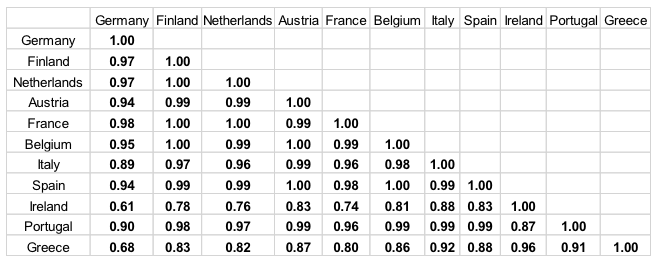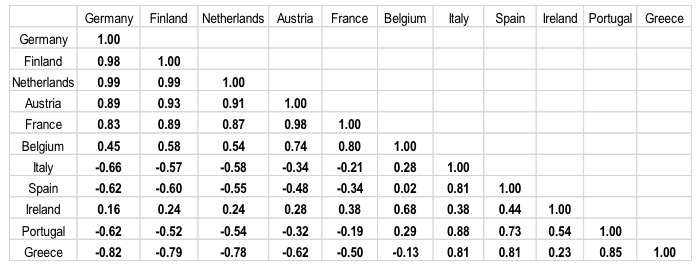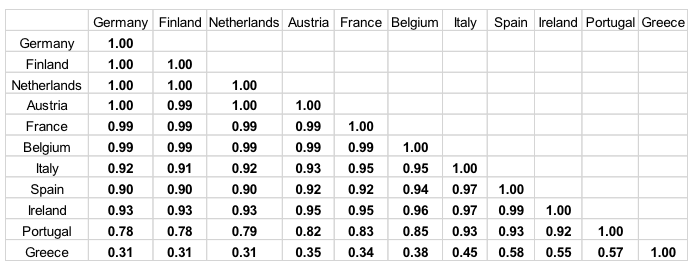One thing we have learned from the financial crisis is that financial markets cannot be trusted as a disciplining device. During the booming years prior to the crisis euphoria dominated in financial markets, leading consumers, banks, firms, and investors to be blind to risk (Kindleberger 1978, Minsky 1986). As a result, encouraged by equally euphoric rating agencies, they took up massive amounts of debt, disregarding the risks they took on their balance sheets. This was the time financial markets considered that Greek sovereign bonds exhibited the same risk as German sovereign bonds. Financial markets were an engine of indiscipline.
When the crash came, financial markets panicked. Suddenly they detected risks everywhere, forcing consumers, firms, and governments into excessive austerity and thereby deepening the recession (De Grauwe and Ji 2013). Financial markets became engines of excessive discipline.
All this is not new. Those who are interested in economic history and read deceased economists (Kindleberger 1978, Minsky 1986) have known for some time that financial markets almost never apply the right amount of discipline (see also Lo 2012). During booms markets apply too little discipline, thereby amplifying the boom; during recessions they impose too much discipline, thereby making the downturn worse.
It is therefore surprising that a number of economists and officials have recently proposed different schemes aiming at using financial markets to impose the right amount of discipline in the euro area. A group of French and German economists has proposed various schemes, such as sovereign bankruptcy procedures and triggers, that would force governments to issue different tranches of debt in the hope of garnering the disciplining powers of the markets (Bénassy-Quéré et al. 2018, Lane and Langfield 2018). The European Systemic Risk Board published a report containing a proposal to create a ‘safe asset’ for the euro area that is based on a repackaging of the risks of sovereign bonds (ESRB 2018). The hope is that this financial engineering will stabilise an otherwise unstable system of sovereign bond markets in the euro area.
In this column, we discuss these two proposals and analyse whether the financial engineering that is implicit in them will help to stabilise the euro area. We will argue that financial engineering cannot stabilise a financial system that is fundamentally unstable.
We first describe the nature of the instability of the government bond markets in a monetary union (De Grauwe 2011, De Grauwe and Ji 2013). We then analyse whether the proposals will succeed in stabilising government bond markets in the euro area.
The instability of government bond markets in a monetary union
The instability of the sovereign bond markets in the euro area can be described as follows. National governments in a monetary union issue debt in a currency that is not their own, but is equivalent to a foreign currency. As a result of this lack of control over the currency in which the bonds are issued, these governments cannot guarantee that the bondholders will always be paid out at maturity. This contrasts with governments of countries issuing their own currency. These governments can give a full guarantee to the bondholders because they know that the central bank stands ready to provide liquidity in times of crisis.
All this leads to a situation in which government bond markets in a monetary union can be hit by self-fulfilling crises: investors, distrusting the capacity (or willingness) of a government to continue to service its debt, sell the bonds, thereby raising the yields and making it more difficult for that government to roll over its debt. A liquidity crisis erupts which results from a fear that the government will be hit by a liquidity crisis. This usually happens during recessions when budget deficits and government debts increase automatically. Investors will then single out those governments perceived to be most at risk, sell their bonds, and acquire bonds issued by governments perceived to be less risky. As a result, massive capital flows across the borders of the monetary union are set in motion, destabilising the whole system. This is exactly what happened during the sovereign debt crisis of 2010-12.
The instability of the government bond markets in a monetary union is aggravated by a possible ‘doom loop’ between the banks and the sovereign. When banks are in trouble, the sovereign who is obliged to save the banks will also be hit by a liquidity, and possibly a solvency, crisis. This was the problem for Ireland. The reverse can also happen: a sovereign debt crisis leads domestic banks, holding large amounts of domestic sovereign bonds, into illiquidity and insolvency (the Greek problem). The doom loop amplifies a sovereign debt crisis. That does not mean, though, that sovereign debt crises and the ensuing destabilising capital flows cannot erupt in the absence of a banking crisis.
Let us now turn to the two proposals mentioned earlier.
1. The Franco-German reform proposals
There is much of intellectual value in the Franco-German reform proposals with which we agree (such as the proposals to complete the banking union and to create some fiscal space at the euro area level). Here, we concentrate on two proposals that aim at enforcing market discipline by financial engineering.[1]
- The first is a proposal to change the existing structural budget balance rule by an expenditure rule that, if exceeded, would force governments to issue junior debt.
- The second proposal aims to enforce sovereign debt default procedures on governments that have become insolvent.
Let us discuss these consecutively.
The idea behind the proposal to force governments to issue junior debt if their expenditures exceed some threshold value is that this will subject governments to more market discipline. The reasoning is as follows. When governments spend too much, they are forced to finance the extra spending by issuing junior bonds. As a result, the buyers of these bonds will face more risk and demand a risk premium. These governments will thus pay a higher interest rate, which will enforce more discipline. The market will do its job of reining in the tendency of governments to spend too much.
All this sounds plausible. The evidence from past financial cycles of booms and busts, however, is that this disciplining mechanism typically fails. During booms, euphoria prevails and few investors perceive risks. As mentioned earlier, during the euro area boom years, investors saw no difference in risk between Greek and German sovereign bonds. It is likely that when euphoria prevails, they will see no significant difference in risks between the different tranches of outstanding government bonds.
During the downturn, exactly the opposite will happen. In fact, the existence of junior bonds will work as wake-up call and set in motion panic reactions of flight. As a result, governments which have issued junior bonds are more likely to be hit by a self-fulfilling liquidity crisis, forcing them into excessive discipline and austerity.
The reality is that financial markets are not well-equipped to enforce discipline on sovereigns. The introduction of some new financial instrument will not change that reality. (It should be noted that the Franco-German reforms proposals also include a proposal to create a safe asset; we discuss this separately below).
The second proposal of the French and German economists aims at instituting a formal sovereign debt restructuring procedure. As these economists argue, governments that are insolvent should be forced to restructure their debt. In other words, the holders of these governments’ bonds should be forced to accept losses. As a result, investors would realise that, without a possible bailout by the sovereign, their investments would be risky. This would lead them to ask for a risk premium, thereby introducing market discipline on the behaviour of the sovereign.
Again, at first sight this sounds reasonable. The same criticism we levelled against the forced issue of junior bonds, however, applies here too. There is very little evidence that investors ask for risk premia during boom phases – that’s when euphoria blinds them into not seeing risks properly. And during the bust phase the opposite occurs – that’s when the knowledge of the existence of debt restructuring procedures will act as triggers that create fear and panic. As a result, the existence of a sovereign restructuring procedure may actually trigger crises more easily during the bust.
There is an additional problem with this proposal, which has to do with identifying when governments are insolvent. It is easy to say that an insolvent sovereign should be forced to restructure his debt. It is much more difficult, during crises moments, to distinguish between solvency and liquidity problems. This difficulty arose during the sovereign debt crisis of 2010-12. It was relatively easy to conclude that the Greek government was insolvent, but what about countries like Ireland, Spain, or Portugal? These countries were gripped by massive sales of their sovereign bonds, leading to a liquidity crunch that made it impossible to roll over their debt at normal market conditions. Quite a few economists concluded that these countries were insolvent and should restructure their debt. It turned out that this advice was wrong and that these countries were solvent but had become illiquid. Had they been forced to restructure their debt, economic recovery would have been much more difficult.
2. The safe asset proposal
The proposal to create a safe asset in the euro area which was made by the ESRB explicitly aims at eliminating the destabilising capital flows across the borders of the monetary union and at stabilising the system. Will it do this? This is the question we now turn to.
In contrast with earlier proposals to create Eurobonds (De Grauwe and Moesen 2009, Delpla and von Weizsäcker 2010), which assume that participating governments are jointly liable for the service of the national debts, the ‘safe asset’ proposal makes no assumption of joint liability. Instead, in this proposal national governments are individually liable for their own debt. There is no pooling of risks.
The ‘safe asset’ is created when financial institutions (private or public) buy a portfolio of national government bonds (in the primary or in the secondary markets) and use this portfolio as a backing for their own issue of bonds, called ‘sovereign bond-backed securities’ (SBBSs). These have the following characteristics.
- One tranche, the junior tranche, is risky. When losses are posted on the underlying portfolio of government bonds, the junior tranche takes the hit.[2]
- The second tranche, the senior tranche, is safe.
The proponents of SBBSs take the view that a 30% junior tranche is a large buffer to take potential losses on the underlying sovereign bonds so as to make the senior tranche (70%) risk-free. Based on simulations of underlying risk patterns, the authors claim that their proposal will allow the size of safe assets in the euro area to more than double. In addition, they claim that the existence of SBBSs will replace the destabilising capital flows across national borders in the euro area by a movement from the risky asset (the junior tranche) into the safe asset (the senior tranche), thereby eliminating instability in the euro area.
How likely is it that these SBBSs will help to stabilise the euro area? Note that in the way we formulate the question we do not dispute that, in normal times, the creation of a safe asset may not increase the efficiency of the financial system in the euro area. It probably will do so by supplying a new type of asset that can provide for a better diversification of normal risks. The issue is whether the safe asset will be an instrument for dealing with systemic risks in times of crisis. Our answer is negative for the following reasons.
First, the creation of a safe asset does not eliminate the national government bond markets. This is recognised by the proponents of a safe asset (ESRB 2018, Brunnermeier et al. 2016). In fact, these proponents have made the continuing existence of national sovereign bond markets a key component of their proposal. According to the ESRB, “the SBBS issuance requires price formation in sovereign bond markets to continue to be efficient” (ESRB 2018: 33). The markets for sovereign bonds must remain large enough so as to maintain their liquidity. That is also why the ESRB proposes to limit the total SBBS issuance to at most 33% of the total outstanding stock of sovereign bonds.
This constraint on the issue of SSBSs implies that national sovereign bond markets will be ‘alive and kicking’. As a result, the major problem that we identified earlier – the potential for destabilising capital flows across the borders of the monetary union – will still be present. However, since the markets of sovereign bonds will have shrunk, the yields are likely to be more volatile during crisis periods.
Second, we observe that during crises, the correlation pattern of yields changes dramatically. Yields in high-risk assets become highly positively correlated, reflecting the dynamics of contagion. At the same time as investors are looking for safe havens, the yields in the safe assets tend to decline sharply and become negatively correlated with the high-risk yields. This pattern was very pronounced during the sovereign debt crisis of 2010-12. In their simulations of the risks involved in SBBSs, Brunnermeier et al. (2016) do take into account the fact that risks can be correlated. However, this correlation pattern is fixed, while during crisis periods correlation patterns change dramatically. We show this feature in Table 1. We find that during the sovereign debt crisis of 2010-12, the government bond yields of the periphery countries under stress were highly positively correlated. At the same time, these yields were negatively correlated with the yields of the core (safe) countries such as Germany, Finland, France, and the Netherlands.
Table 1a Correlation of yields before crisis (2000M1-2009M12)
Table 1b Correlation of yields during crisis (2010M1-2012M09)
Table 1c Correlation of yields after crisis (2012M10-2017M12)
Source: European Central Bank and authors’ own calculations.
Note: The yields are yields on 10-year government bonds.
The implication is that during crises it is very unlikely that the senior tranche in the SBBSs can maintain its status of safe asset. It will consist of bonds that investors dump and ‘safe-haven’ bonds. The senior tranche will continue to depend on the cash flow generated by bonds that panicking investors deem to be extremely risky. The perception that this senior tranche is equally safe as the safe-haven sovereign bonds (e.g. German bonds) is very unlikely when markets are in panic mode. As a result, it is also likely that investors will flee the senior tranches of the SBBSs to invest in the ‘real thing’, i.e. super-safe sovereign national bonds.
A third problem is related to the previous one. During normal times, the safe asset will have been used in the pricing of derivatives and other financial instruments and it will be an important part of the repo market providing liquidity in that market. As a result, a large part of the financial markets in the euro area will depend on the perceived safety and liquidity of the SBBS construction. When, during crisis periods, the safety of that construction is put into doubt (as we argued in the previous section), liquidity will tend to disappear and the whole financial sector of the euro area will be at risk. In the end we may have more rather than less financial stability in the Eurozone.
There is an historical analogy here. During the boom years, collateralised debt obligations (CDOs) were created backed by different types of securities (for example, mortgages). At the time, many people were enthusiastic about this and believed that CDOs would make the financial markets more efficient via a better spreading of risks. Ultimately, it was believed, this would lead to more financial stability. The SBBSs proposed by the ESRB has the same CDO structure as the previous ones. It would be surprising if financial engineering, which in the past failed dismally in stabilising financial markets, were to do so in the future.
Conclusion
We have argued that various recent proposals aimed at stabilising the euro area via financial engineering do not eliminate the inherent instability of the sovereign bond markets in a monetary union. During crises this instability becomes systemic, and no amount of financial engineering can stabilise an otherwise unstable system.
The proposals made by the French and German economists (Bénassy-Quéré et al. 2018) have clearly be inspired by concerns about moral hazard. These concerns are very intense among German economists and have left their mark on the reform proposals of the Franco-German group of economists. Moral hazard means that agents consciously take too much risk because they expect others to bail them out. It is very unlikely, however, that the sovereign debt crisis had much to do with moral hazard. It stretches the imagination to believe that the Greek, Irish, Portuguese, or Spanish governments decided to allow their debt levels to increase in the expectation that they would be bailed out by the governments of Northern euro area countries.
Our hypothesis that the sovereign debt crisis erupted as a result of a boom that led private and public agents to disregard risk makes more sense. But even if moral hazard was a cause of the crisis, those who took on too much risk will have learned that the punishment for being bailed out by Northern euro area governments is severe. It should by now be clear that no government would wish to be bailed out by these governments.
Stabilisation via financial engineering will not work. Real stabilisation of the euro area goes through two mechanisms.
The first is the willingness of the ECB to provide liquidity in the sovereign bond markets of the euro area during times of crisis. The ECB has set up its Outright Monetary Transactions (OMT) programme to do this. However, OMT is loaded with austerity conditions, which will be counterproductive when used during recessions (which is when crises generally occur). That is why a second mechanism is necessary. This consists in creating Eurobonds that are based on joint liability of the participating national governments. Without such joint liability, it will not be possible to create a common sovereign bond market. The creation of such a common bond market is the conditio sine qua non for long-term stability the Eurozone.
The political willingness to go in this direction, however, is non-existent today. There is no willingness to provide a common insurance mechanism that would put taxpayers in one country at risk of having to transfer money to other countries. Under those conditions, the sovereign bond markets in the euro area will continue to be prone to instability.
The danger of financial engineering proposals is that they create a fiction allowing policymakers to believe that they can achieve the objective of stability via some technical wizardry without having to pay the price of a further transfer of sovereignty.
References
Benassy-Quéré, A et al. (2018), “Reconciling risk sharing with market discipline: A constructive approach to euro area reform”, CEPR Policy Insight No 91.
Brunnermeier, M, S Langfield, M Pagano, R Reis, S Van Nieuwerburgh and D Vayanos (2016), “ESBies: Safety in the tranches”, ESRB Working Paper No. 21.
De Grauwe, P (2011), “The Governance of a Fragile Eurozone”, CEPS Working Document.
De Grauwe, P and W Moesen (2009), “Gains for All: A Proposal for a Common Eurobond”, Intereconomics, May/June.
De Grauwe, P and Y Ji (2013), “Self-fulfilling Crises in the Eurozone: An Empirical Test”, Journal of International Money and Finance 34: 15–36.
Delpla, J and J von Weizsäcker (2010), “The Blue Bond Proposal”, Bruegel Policy Brief, May.
European Systemic Risk Board (ESRB) (2018), “Sovereign bond-backed securities: a feasibility study”, January.
Kindleberger, C P (1978), Manias, Panics and Crashes: A History of Financial Crises, Wiley.
Lane, P and S Langfeld (2018), “The feasibility of sovereign bond-backed securities in the euro area”, VoxEU.org, 28 February.
Messori, M and S Micossi (2018), “Counterproductive Proposals on Euro Area Reforms by French and German Economists”, CEPS Policy Insight 2018/04.
Minsky, H (1986), Stabilizing an Unstable Economy, Yale University Press
Tabellini, G (2017), “Reforming the Eurozone: Structuring vs restructuring sovereign debts”, VoxEU.org, 23 November.
Endnotes
[1] For a more general criticism of the Franco-German reform proposals, see Messori and Micossi (2018).
[2] In the ESRB proposal (ESRB 2018), this tranche is split further into two tranches: a junior tranche proper with the highest risk (10%), and a mezzanine tranche (20%) which takes the losses after the junior tranche has been depleted.






